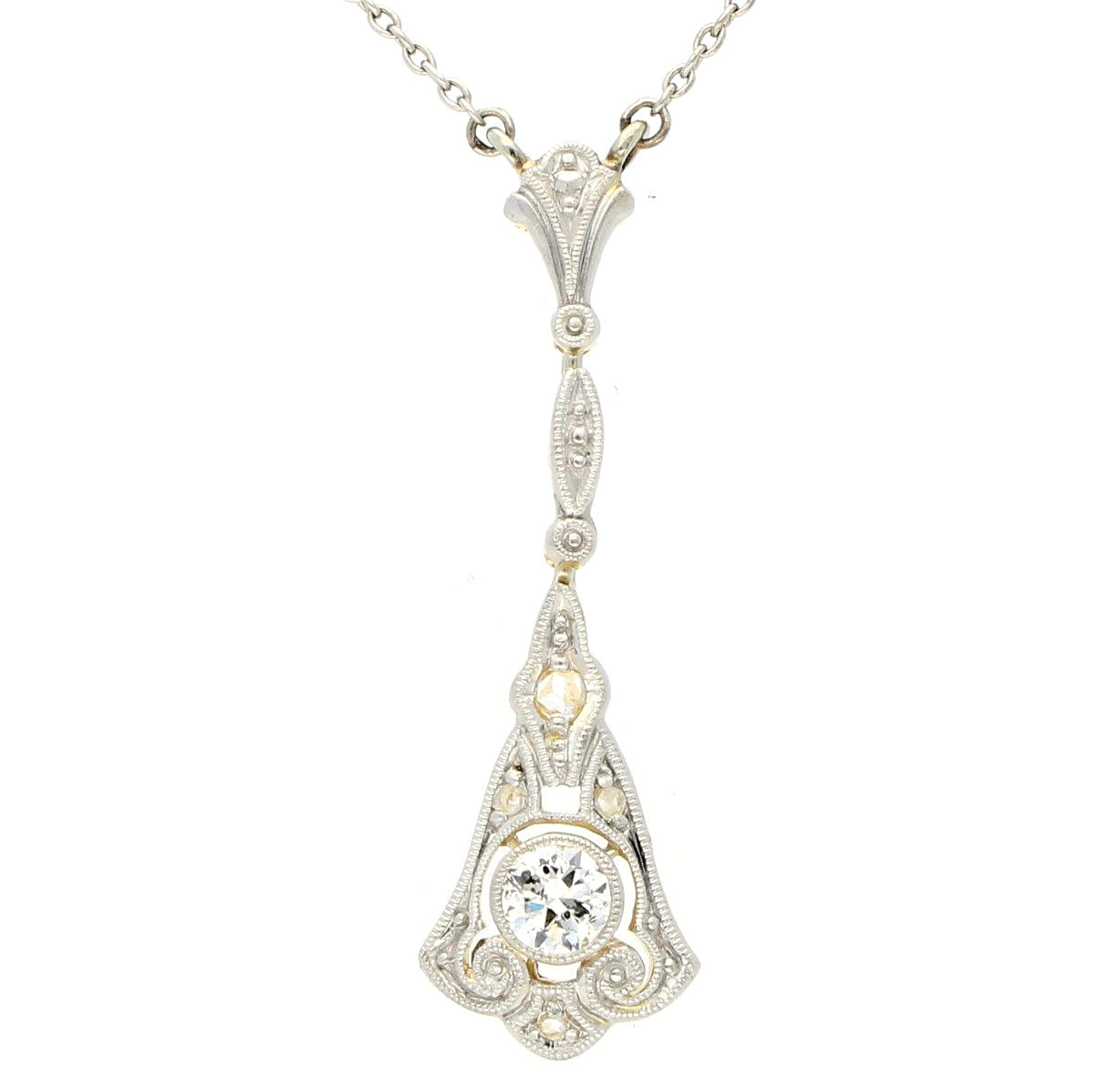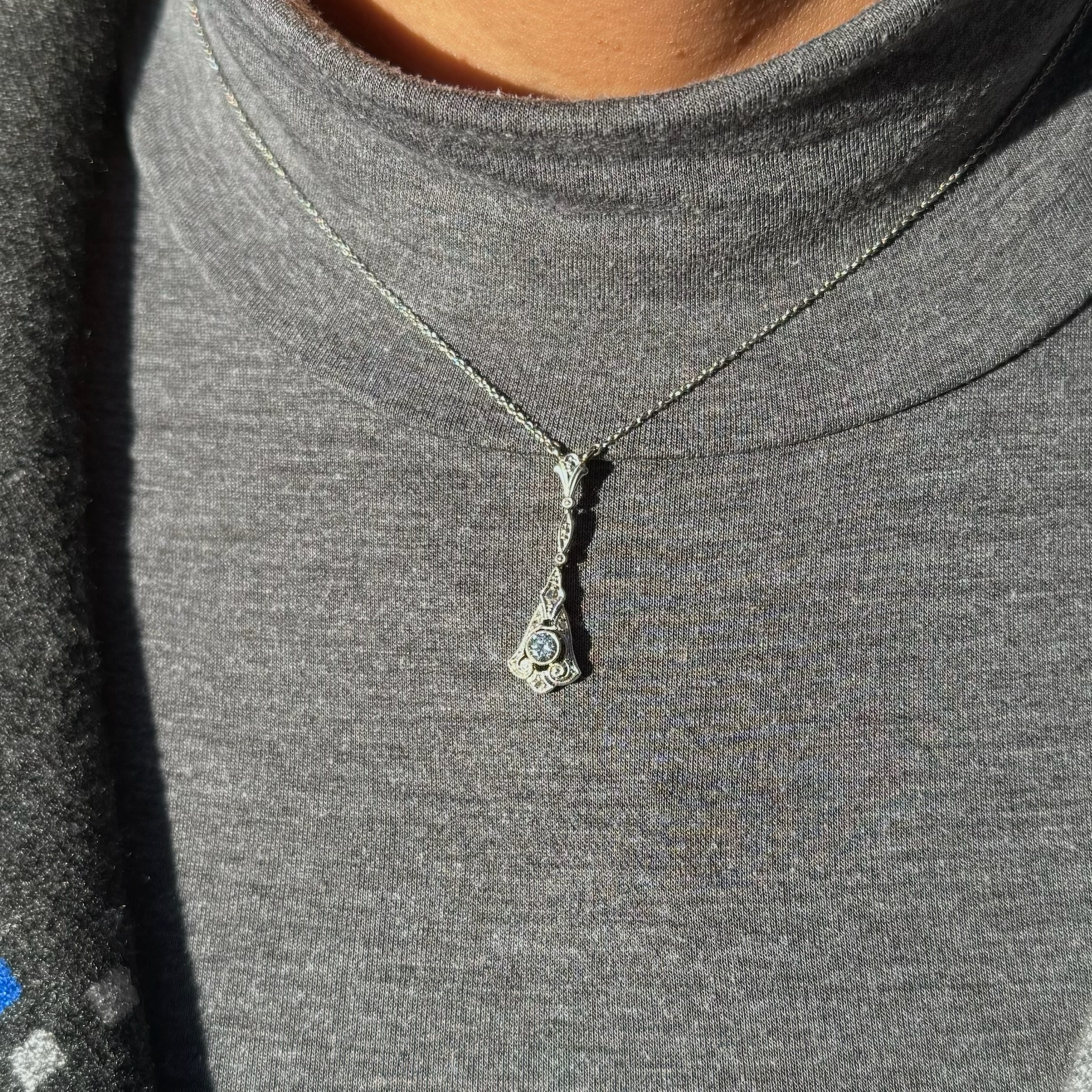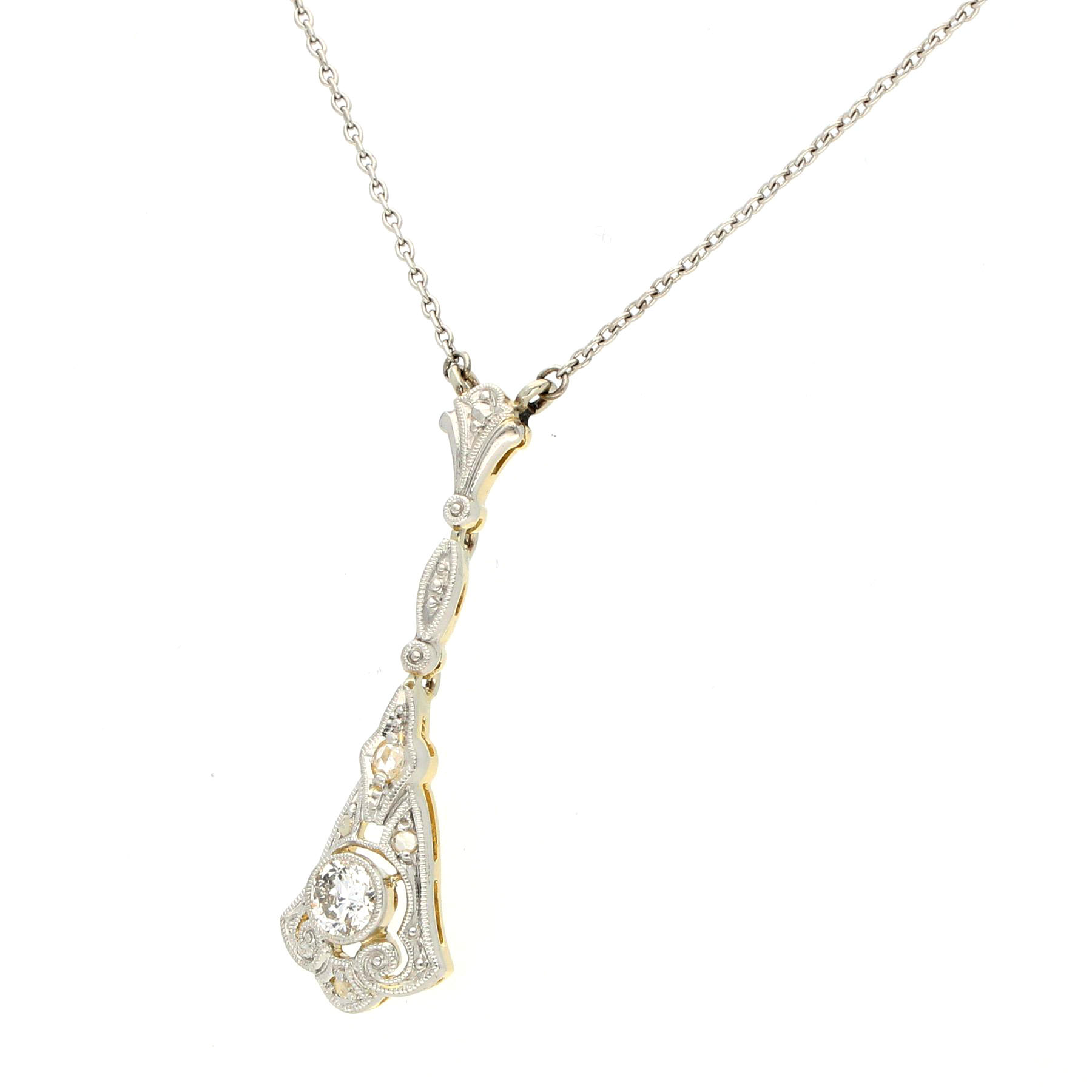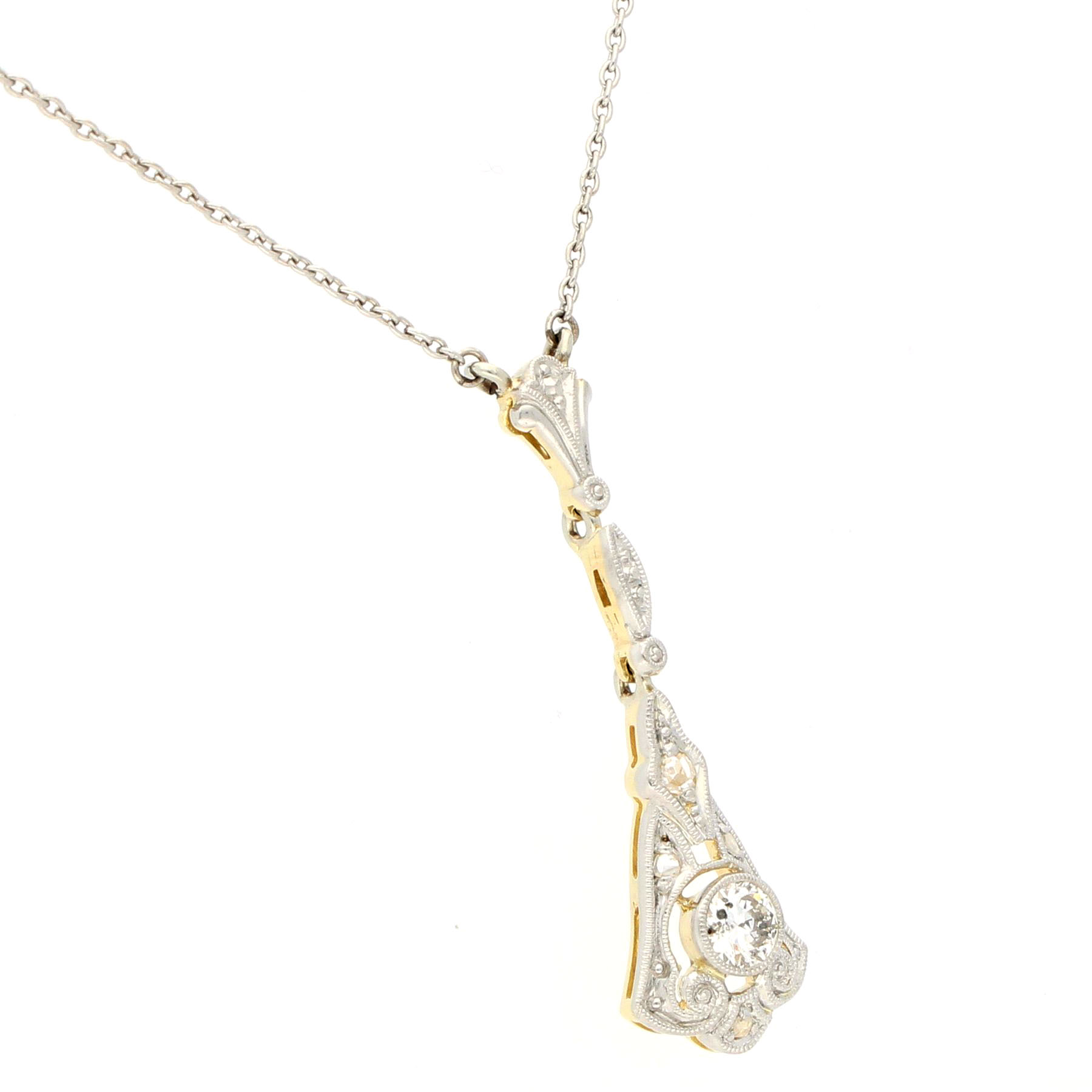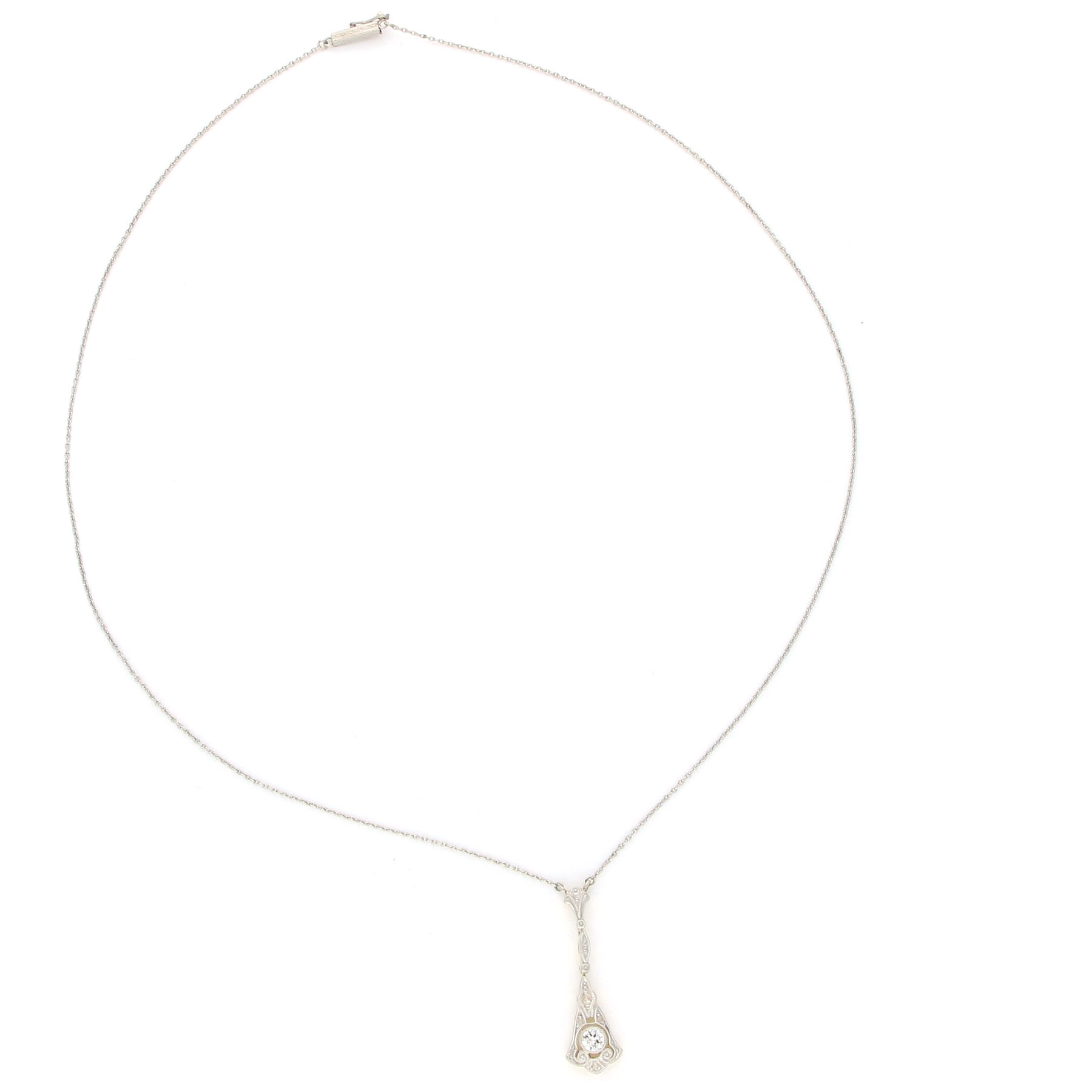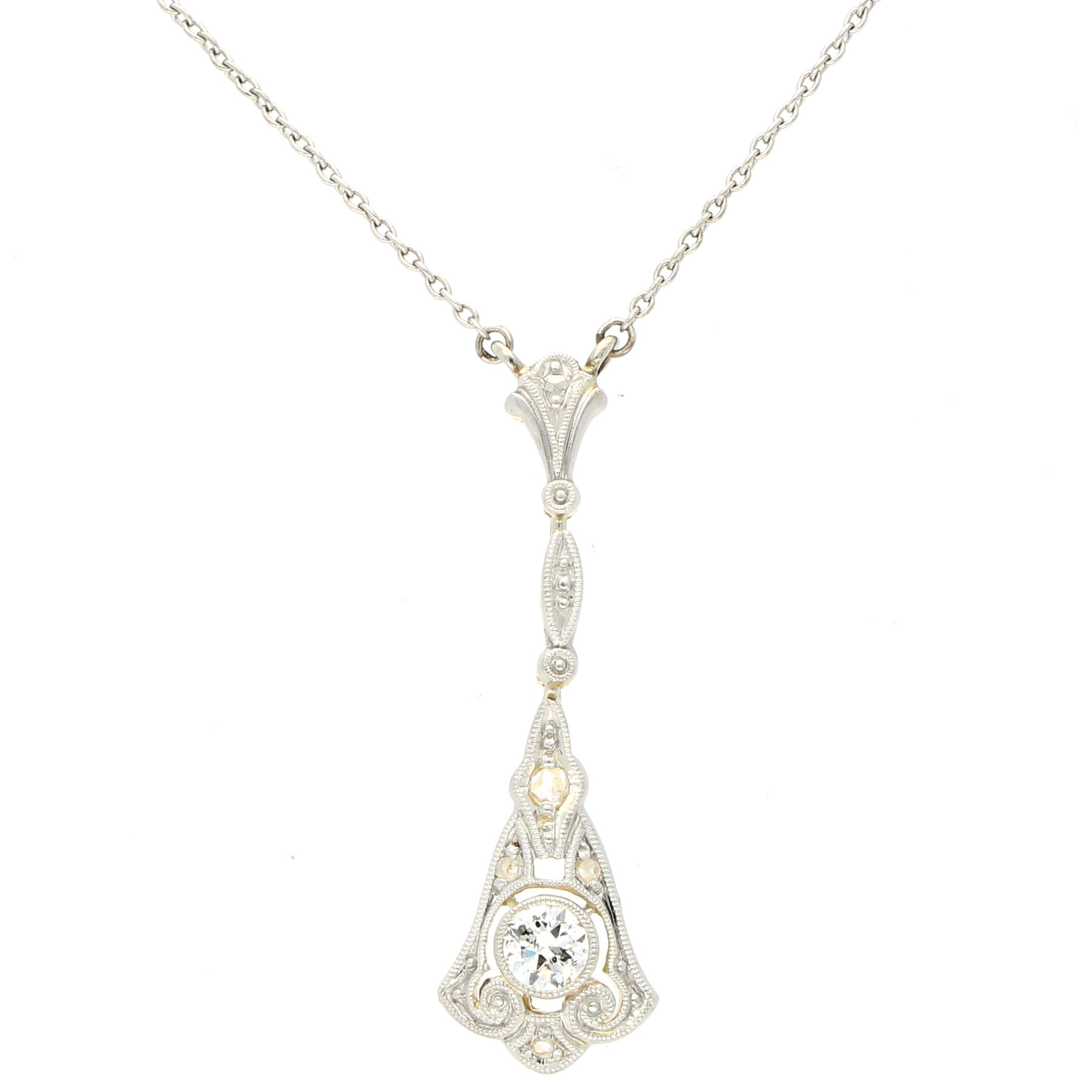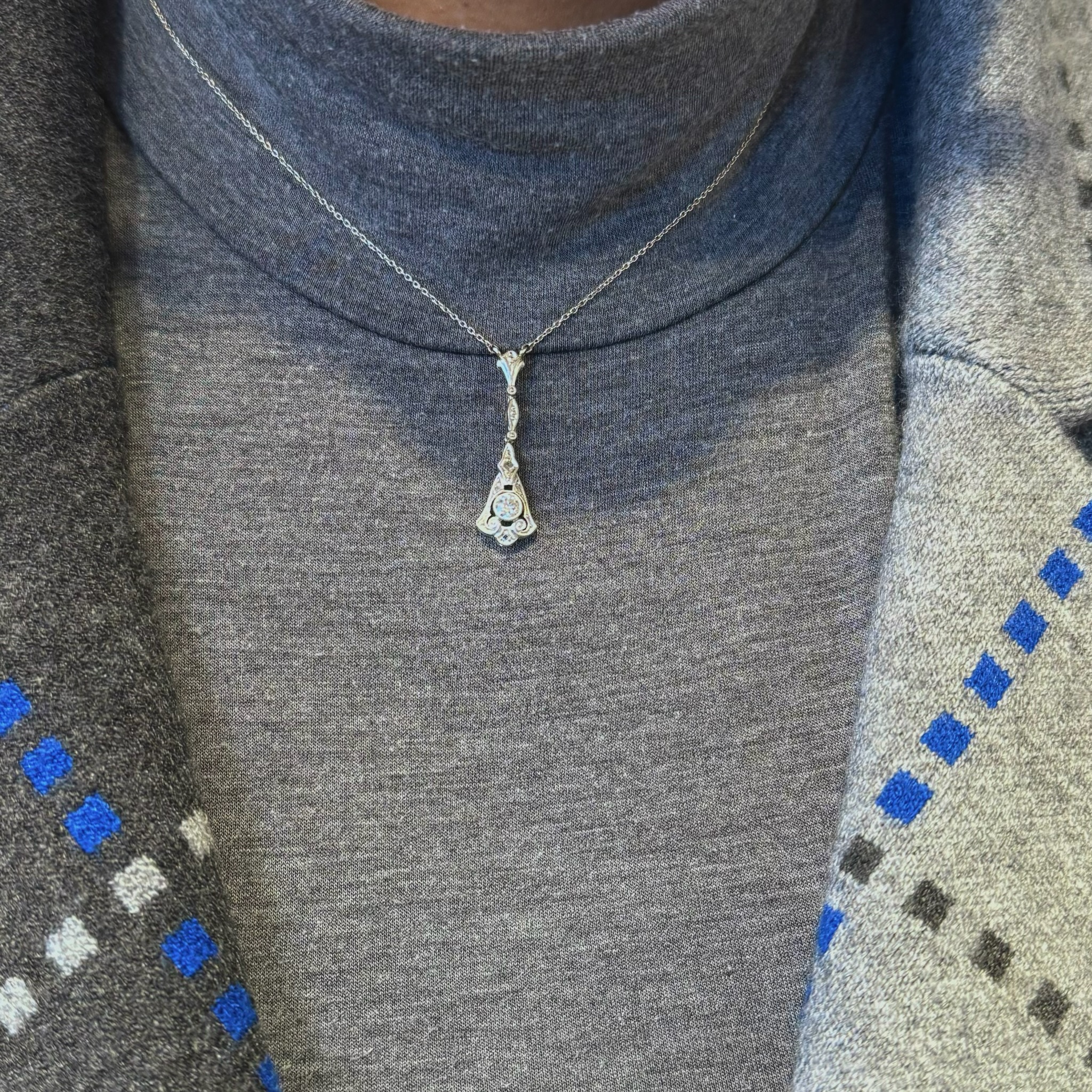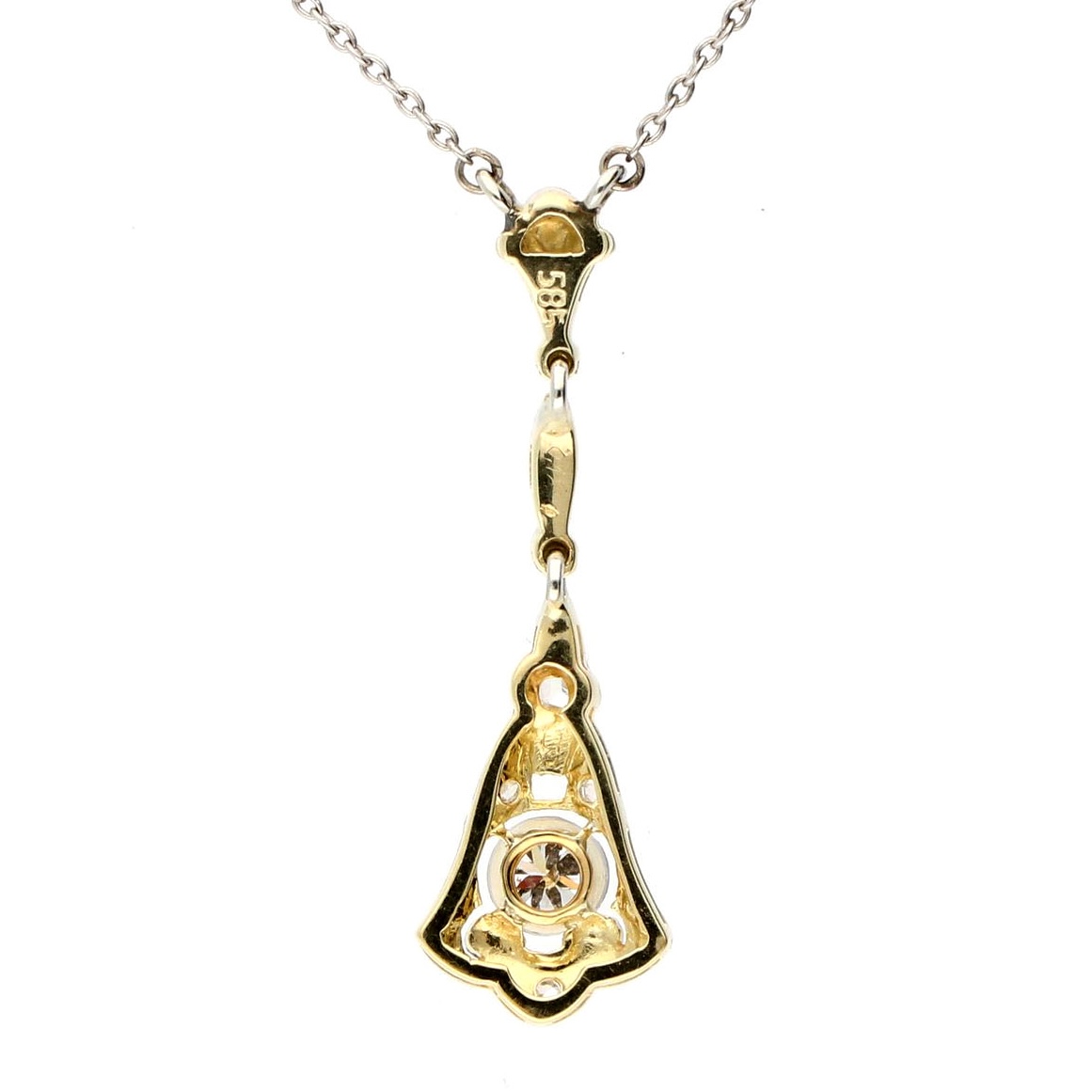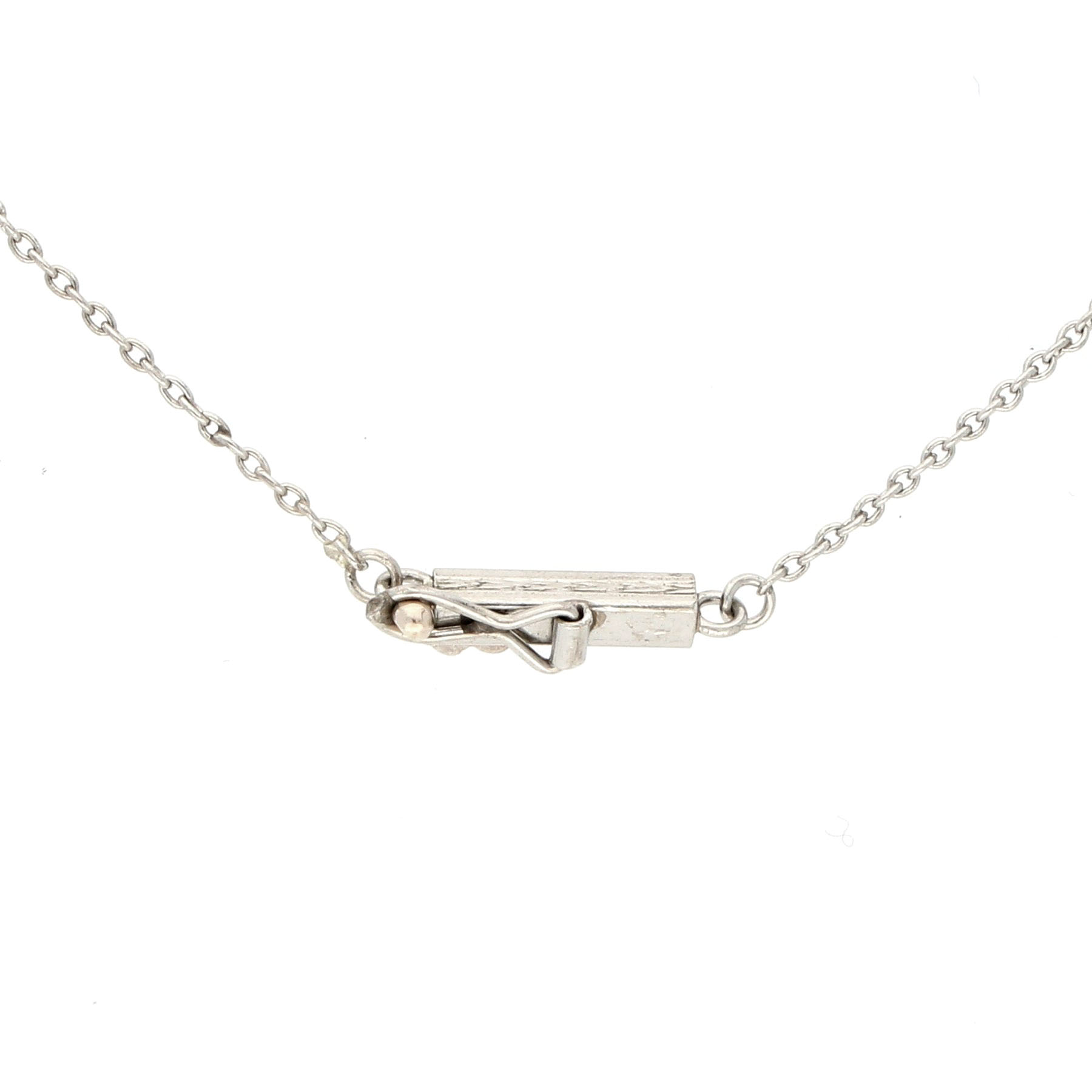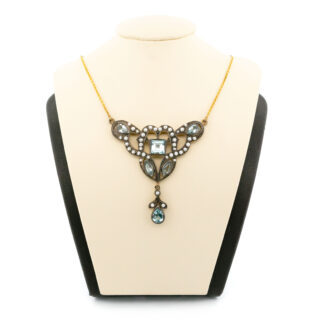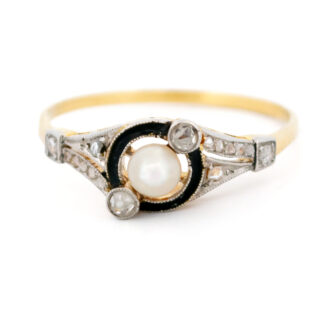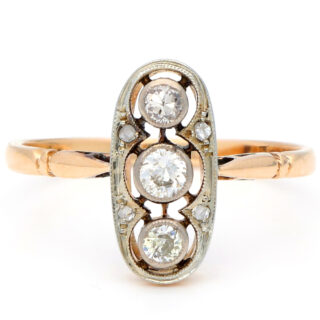This elegant early 20th-century pendant necklace is crafted in 14k yellow and white gold, showcasing a central ±0.24ct old European-cut diamond (H I1) surrounded by delicate rose-cut diamonds. The intricate milgrain detailing and openwork design add vintage charm, creating a piece that embodies the refined style of the 1910-1940 Art Deco era.
Videos
Details: ±0.24ct (H I1) Old-european-cut diamond, Rose-cut diamonds, 14k Necklace.
Design Era: Early 20th Century (1910-1940).
Weight in grams: 2.6.
Condition: Very good condition – slightly used with small signs of wear.
Shipping and Pickup: This splendid piece ships from our store located in the center of Amsterdam, The Netherlands. We offer both registered shipping and local pickup at our store. In the case of local pickup, any applicable shipping costs will be refunded.
About Us: Add some sparkle to your style with Binenbaum.com. We offer a stunning selection of antique and vintage jewelry that you won’t find anywhere else. From timeless rings and dazzling necklaces to unique brooches, we have something for every taste and occasion. Visit our website today and treat yourself to a piece of history.
| Design Era | |
|---|---|
| Design & Historical Context | During the 1910s to 1950s, the design of jewelry remained creative and stylish despite being impacted by economic and military events. Jewelry fashions during this time were influenced by various parts of the world, including the Near and Far East, and featured both exotic and geometric patterns that reflected the emergence of the machine age. New York became an important center for fashion along with Paris, and European jewelry companies had the opportunity to sell to and purchase from the Indian subcontinent. Art Deco jewelry, characterized by the use of numerous gemstones, was popular during this time, and the use of gold in jewelry increased in popularity due to its lower cost compared to platinum. Jewelry design also attracted artists and designers from various fields, giving hints about the direction that the industry would take in the future. |
| Key Materials | |
| Materials & Craftsmanship | Old-european-cut diamond: The Vintage Sparkle of Classic Romance Old European-cut diamonds are a beloved choice for those who appreciate vintage elegance and timeless beauty. This diamond cut, which was predominant from the late 19th century through the early 20th century, is known for its round shape, high crown, small table, and large, open culet. These characteristics give the stone a soft, romantic sparkle that evokes the charm of a bygone era. Historically, the Old European cut was the precursor to the modern round brilliant cut. It was crafted by hand, with each facet carefully shaped to maximize the diamond's brilliance under the softer lighting conditions of the time, such as candlelight. This cut was popular during the Victorian, Edwardian, and Art Deco periods, making it a favorite in antique and vintage jewelry. In modern jewelry, Old European-cut diamonds are highly sought after for their unique sparkle and historical significance. They often exhibit a warmer, more subdued brilliance compared to modern cuts, with an emphasis on depth and fire rather than the bright flashes of light seen in contemporary diamonds. This makes them ideal for engagement rings, earrings, and other pieces that celebrate vintage style and craftsmanship. An Old European-cut diamond is more than just a gemstone; it is a piece of history, reflecting the elegance and romance of the past. Its distinctive charm and enduring beauty make it a perfect choice for those who appreciate the artistry and nostalgia of vintage jewelry. Rose-cut diamond: The Vintage Gem of Romance and Light Rose-cut diamonds are a beautiful and romantic choice in the world of jewelry, known for their distinctive dome-shaped appearance and soft, glowing sparkle. This antique diamond cut, dating back to the 16th century, features a flat bottom and a domed top covered in triangular facets that resemble the petals of a rosebud—hence the name. Historically, rose-cut diamonds were highly prized during the Georgian and Victorian eras, often used in jewelry pieces meant to be worn in candlelight, where their gentle sparkle added a warm, intimate glow. Unlike modern brilliant cuts, which are designed for maximum fire and brilliance, rose-cut diamonds offer a more subdued, yet enchanting, reflection of light. In modern jewelry, rose-cut diamonds are cherished for their vintage appeal and unique charm. Their flat base and shallow profile make them perfect for creating low-profile, elegant designs that sit close to the skin, such as in rings, pendants, and earrings. Rose-cut diamonds are often used in vintage-inspired and bespoke pieces, where their historical elegance adds a touch of timeless romance. Rose-cut diamonds are more than just a gemstone choice; they are a symbol of understated beauty and classic romance. Their soft, luminous sparkle and antique allure make them an ideal choice for jewelry that tells a story and captures the essence of a bygone era. 14k: The Durable Choice for Everyday Elegance 14k gold is a popular and practical choice in fine jewelry, known for its durability, affordability, and beautiful color. The "14k" signifies that the gold is composed of 58.3% pure gold and 41.7% alloyed metals, such as copper, silver, nickel, or zinc. This combination results in a strong and resilient material that can withstand the rigors of daily wear, making it an ideal option for those seeking both beauty and durability. Historically, gold has always been a symbol of wealth and luxury, and 14k gold strikes a perfect balance between the rich appearance of gold and the strength needed for everyday use. Because of its lower gold content compared to 18k or 24k gold, 14k gold is more affordable, making it a popular choice for a wide range of jewelry pieces. In modern jewelry, 14k gold is appreciated for its versatility and variety. It is available in several colors, each achieved by mixing gold with different metals: Yellow Gold: A classic and timeless choice, 14k yellow gold has a warm, golden hue that complements most skin tones and is well-suited for both modern and traditional designs. White Gold: Created by alloying gold with white metals like nickel or palladium, 14k white gold has a sleek, silver-like appearance. It is often rhodium-plated for added shine and is a popular choice for engagement rings and other contemporary jewelry. Rose Gold: Achieved by mixing gold with copper, 14k rose gold has a soft, pinkish hue that has gained popularity for its romantic and vintage appeal. It is a favorite for those seeking a unique and stylish alternative to traditional gold colors. 14k gold is commonly used in a wide array of jewelry, including rings, necklaces, bracelets, earrings, and watches. Its durability makes it especially suitable for pieces that are worn daily, such as wedding bands and engagement rings, where the balance between strength and beauty is crucial. 14k gold is more than just a practical choice; it is a symbol of enduring style and everyday luxury. Its ability to retain the look of gold while offering greater resistance to scratches and dents makes 14k gold a versatile and timeless option for any jewelry collection. Whether in a simple band or an elaborate design, 14k gold offers a perfect blend of elegance and durability that can be enjoyed for years to come. |
| Gender | |
| Weight (in grams) | 2.6 |
| Condition | Very good condition – slightly used with small signs of wear |
Enhance the Beauty of Your Jewelry with Proper Care
Wearing your jewelry is a special way to express yourself and add a touch of personal style to any look. However, to ensure your jewelry remains in pristine condition, there are a few simple steps you need to take to keep it looking its best.
General Care Instructions:
Remove jewelry when showering or bathing, especially when at the beach, in the sea or in chlorinated water.
Avoid wearing jewelry while doing physical work such as housekeeping, gardening or exercise.
Storing your jewelry in a dry and cool place will help protect it from moisture, dirt and dust.
Keeping it away from harsh chemicals such as bleach, ammonia and chlorine will help to avoid discoloration and damage.
Cleaning your jewelry regularly with a soft cloth will help to keep it looking shiny and new.
Avoid exposing your jewelry to extreme temperatures, such as leaving it in direct sunlight or near a heater, as this can cause damage.
Handle your jewelry carefully and avoid dropping it, as this can cause the stones to loosen or the metals to scratch.
Finally, if possible, have your jewelry professionally checked and serviced. This will ensure that any potential problems are spotted and fixed before they become worse.
By following these tips, you can enjoy your precious jewelry for many years to come.
Related Products
-
Diamond 18k Platinum Lavalier Necklace 7022-1926
€ 2.795,00 VAT incl. (where applicable) -
Diamond 14k Negligee Necklace 16361-8819
€ 1.595,00 VAT incl. (where applicable) -
Diamond 18k Vintage Necklace 12789-7054
€ 3.495,00 VAT incl. (where applicable) -
Topaz Pearl 9k Silver Lavalier Necklace 10223-6515
€ 1.495,00 VAT incl. (where applicable) -
Diamond 18k Tennis Necklace 12788-7053
€ 7.995,00 VAT incl. (where applicable) -
Diamond Enamel Pearl 18k Platinum Trilogy Ring 15905-2465
€ 1.395,00 VAT incl. (where applicable) -
Diamond 14k Floral Ring 16914-9016
€ 2.495,00 VAT incl. (where applicable) -
Diamond 14k Trilogy Ring 16902-9008
€ 1.695,00 VAT incl. (where applicable)
- Home
- Collection
- Fine Jewelry
- Silver Jewelry
- Silverware
- Boxes
- Candlesticks
- Salt and pepper shakers
- Miniatures
- Salt cellars
- Spoon Set
- Condiments
- Frames
- Napkin Ring
- Spoon
- Oddities
- Cups
- Vases
- Cutlery
- Serving Spoon And Cake Server
- Candlesticks
- Baskets
- Hanukkiah
- Spice Tower
- Yad
- Tea Set
- Sugar Castor
- Napkin Rings
- Wine Bottle Coaster
- Wine Stopper
- Tea Pot
- Jugs
- Rattles
- Hip Flask
- Miscellaneous
- Rings 💍
- About
- Contact
